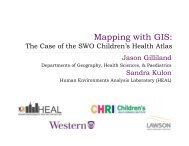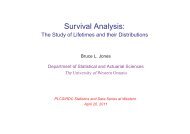How does ICES do it? - Research Data Centre
How does ICES do it? - Research Data Centre
How does ICES do it? - Research Data Centre
- No tags were found...
Create successful ePaper yourself
Turn your PDF publications into a flip-book with our unique Google optimized e-Paper software.
Introduction to the<br />
Inst<strong>it</strong>ute for Clinical Evaluative Sciences (<strong>ICES</strong>)<br />
and <strong>ICES</strong> expansion s<strong>it</strong>e, <strong>ICES</strong>@Western<br />
November 7, 2012<br />
CPAH/RDC Statistics and <strong>Data</strong> Series at Western<br />
Am<strong>it</strong> Garg, Director <strong>ICES</strong>@Western<br />
Theresa Hands, Privacy Officer<br />
Salimah Shariff, Lead Epidemiologist<br />
Enhancing the effectiveness of health care<br />
for Ontarians through research
2<br />
Outline<br />
• Who are we?<br />
• What <strong><strong>do</strong>es</strong> <strong>ICES</strong> <strong>do</strong>?<br />
• What <strong><strong>do</strong>es</strong> <strong>ICES</strong>@Western offer?<br />
• Where is <strong>ICES</strong>@Western located?<br />
• When will <strong>ICES</strong>@Western be operational?<br />
• <strong>How</strong> <strong><strong>do</strong>es</strong> <strong>ICES</strong> <strong>do</strong> <strong>it</strong>?<br />
Enhancing the effectiveness of health care<br />
for Ontarians through research
3<br />
Who are we?<br />
<strong>ICES</strong><br />
• Independent, non-prof<strong>it</strong> organization<br />
• Conducts research that contributes to:<br />
effectiveness, qual<strong>it</strong>y, equ<strong>it</strong>y and efficiency of<br />
health care and health services in Ontario<br />
Enhancing the effectiveness of health care<br />
for Ontarians through research
Who are we?<br />
Network of Health Services <strong>Research</strong> <strong>Centre</strong>s<br />
4<br />
Opened 2012<br />
Enhancing the effectiveness of health care<br />
for Ontarians through research
What <strong><strong>do</strong>es</strong> <strong>ICES</strong> <strong>do</strong>?<br />
<strong>ICES</strong> goals<br />
5<br />
• Carry out population-based health services research<br />
that is relevant to clinical practice and health policy<br />
development<br />
• Document province-wide patterns and trends in<br />
health care delivery<br />
• Develop and share evidence to inform decisionmaking<br />
by policy makers, managers, clinicians,<br />
planners and consumers<br />
Enhancing the effectiveness of health care<br />
for Ontarians through research
What <strong><strong>do</strong>es</strong> <strong>ICES</strong> <strong>do</strong>?<br />
<strong>ICES</strong> goals<br />
6<br />
• Promote linkages among health services<br />
researchers and decision-makers<br />
• Train researchers and promote a wider<br />
understanding of epidemiology and health services<br />
research<br />
Enhancing the effectiveness of health care<br />
for Ontarians through research
7<br />
What <strong><strong>do</strong>es</strong> <strong>ICES</strong> <strong>do</strong>?<br />
Examples of <strong>ICES</strong> studies<br />
• Some of these you may have heard of….<br />
Mortal<strong>it</strong>y among Patients Adm<strong>it</strong>ted to Hosp<strong>it</strong>als on<br />
Weekends as Compared w<strong>it</strong>h Weekdays (NEJM, 2001)<br />
Cyclo-oxygenase-2 inhib<strong>it</strong>ors versus non-selective nonsteroidal<br />
anti-inflammatory drugs and congestive heart<br />
failure outcomes in elderly patients: a population-based<br />
cohort study (Lancet, 2004)<br />
Unwalkable neighborhoods, poverty, and the risk of<br />
diabetes among recent immigrants to Canada compared<br />
w<strong>it</strong>h long-term residents (Diabetes Care, 2012)<br />
Enhancing the effectiveness of health care<br />
for Ontarians through research
<strong>ICES</strong> Ontario, Canada<br />
linked database characteristics<br />
Cost: if had to collect data same data prospectively or<br />
through medical chart review very expensive.
Question<br />
Do kidney<br />
<strong>do</strong>nors<br />
compared to<br />
non <strong>do</strong>nor<br />
controls of<br />
similar health<br />
have a higher risk of<br />
major cardiovascular<br />
events<br />
when followed<br />
for years after<br />
<strong>do</strong>nation?<br />
Garg AX et al. BMJ 2012
We conducted a retrospective,<br />
population-based, matched cohort<br />
study that used large Ontario, Canada<br />
population-based healthcare<br />
databases
Ontario Residents<br />
Restriction: Excluded any Ontario<br />
resident w<strong>it</strong>h a medical cond<strong>it</strong>ion before<br />
their index date that could preclude<br />
<strong>do</strong>nation:<br />
Ran<strong>do</strong>mly assigned an index date to entire Ontario i.e. population kidney disease, DM, HTN, Cancer,<br />
(using same distribution of index dates in <strong>do</strong>nors) CVD, pulmonary dx, liver dx, SLE,<br />
chronic infections, HIV<br />
This provided on average of 11 years of medical From records 9.6 million for baseline Ontarians assessment, this resulted in<br />
w<strong>it</strong>h 99% of people having at least two years of exclusion baseline of data 85% for of review adults (15% remained)<br />
Healthy Non-Donors<br />
Living Kidney Donors<br />
1992-2009<br />
- Manual review of all charts<br />
Date of nephrectomy<br />
referred to as index date<br />
(start time of follow-up)<br />
Match each <strong>do</strong>nor to 10 non-<strong>do</strong>nors<br />
Age Non-Donors (±2 years), Sex (controls)<br />
Index of similar Date health (±6 months) as <strong>do</strong>nors<br />
Income and Residential Status
Some Baseline Characteristics<br />
Living Kidney Donors<br />
(N = 2028)<br />
Non-Donors<br />
(N = 20,280)<br />
Age at Index Date, Years (IQR) 43 (34-50) 43 (34-50)<br />
Age Last Follow-Up, Years (IQR) 50 (42-58) 50 (42-58)<br />
Women 60% 60%<br />
Follow-Up, years (range) 6.8 (0.5 to 18) 6.5 (0.1 to 18)<br />
Follow-up, total-person years 15,176 147,332
Validated codes were used
Major cardiovascular event (death censored)<br />
Good precision in the estimate<br />
No difference between the groups<br />
Donors: 1.3%; 1.7 events per 1000 person years<br />
Non-<strong>do</strong>nors: 1.4%; 2.0 events per 1000 person years<br />
Hazard ratio 0.85, 95% CI 0.57 to 1.27
Population database strengths<br />
• Large population-based assessment<br />
• <strong>Data</strong>bases allow for rigorous selection of non-<strong>do</strong>nor controls<br />
• F/u up to 18 years, minimal loss to follow-up. (
2) Hepatocytes<br />
2%<br />
Statin Metabolism<br />
CYP3A4 Metabolized Statins<br />
Atorvastatin, simvastatin, lovastatin<br />
2% Systemic Availabil<strong>it</strong>y<br />
40%<br />
1) Enterocytes - Small Intestine<br />
100%<br />
40%
Statin Metabolism + CYP3A4 inhib<strong>it</strong>or<br />
2) Hepatocytes<br />
80%<br />
40%<br />
CYP3A4 Metabolized Statins<br />
Clar<strong>it</strong>hromycin / erythromycin<br />
inhib<strong>it</strong>s CYP3A4<br />
40% Systemic Availabil<strong>it</strong>y<br />
1) Enterocytes - Small Intestine<br />
100%<br />
+<br />
Clar<strong>it</strong>hromycin or Erythromycin<br />
Az<strong>it</strong>hromycin a macrolide<br />
antibiotic used for similar<br />
indications <strong><strong>do</strong>es</strong> not inhib<strong>it</strong><br />
CYP3A4<br />
80%
Population Based Study of Older statin users<br />
w<strong>it</strong>h new outpatient co-prescriptions<br />
Can’t ethically ran<strong>do</strong>mize<br />
Clar<strong>it</strong>hro /<br />
Erythro<br />
(n ~ 75,000)<br />
compared to<br />
Az<strong>it</strong>hro<br />
(n ~ 68,000)<br />
Question:<br />
30 days<br />
a patient to a potentially severe<br />
adverse drug-drug interaction.<br />
Hosp<strong>it</strong>alization w<strong>it</strong>h<br />
rhab<strong>do</strong>myolysis<br />
Hosp<strong>it</strong>alization w<strong>it</strong>h AKI<br />
Would be required to intervene<br />
All cause mortal<strong>it</strong>y<br />
at time knew about worrisome<br />
prescription.<br />
+ AKI based on serum<br />
creatinine<br />
(data in subpopulation)<br />
Patel A et al. (under review) 2012
Baseline Characteristics by co-prescription<br />
Clar<strong>it</strong>hromycin<br />
n=72,591<br />
Erythromycin<br />
n = 3,267<br />
total n = 75,858<br />
Az<strong>it</strong>hromycin<br />
n = 68,478<br />
Demographics<br />
Age, years 74 (SD 6) 74 (SD 6)<br />
Women 40,130 (53%) 36,323 (53%)<br />
Co-morbid<strong>it</strong>ies<br />
Cerebrovascular disease 3,189 (4%) 2,765 (4%)<br />
Peripheral vascular disease 2,101 (3%) 1,844 (3%)<br />
Coronary artery disease 39,908 (53%) 36,950 (54%)<br />
Congestive heart failure 12,652 (17%) 11,776 (17%)<br />
Systemic malignancy 21,875 (29%) 19,955 (29%)
Clar<strong>it</strong>hromycin<br />
n=72,591<br />
Erythromycin<br />
n = 3,267<br />
total n = 75,858<br />
Az<strong>it</strong>hromycin<br />
n = 68,478<br />
Statin Characteristics<br />
Atorvastatin 55,027 (73%) 50,111 (73%)<br />
Simvastatin 18,421 (24%) 16,369 (24%)<br />
Lovastatin 2,410 (3%) 1,998 (3%)<br />
High <strong>do</strong>se statin 30,296 (40%) 27,550 (40%)<br />
Low <strong>do</strong>se statin 45,562 (60%) 40,928 (60%)<br />
Medication use in preceding year<br />
Oral hypoglycemic or insulin 20,367 (27%) 17,819 (26%)<br />
Beta-blockers 29,318 (39%) 27,008 (39%)<br />
Verapamil or diltiazem 7,941 (11%) 7,206 (11%)<br />
Use of other calcium channel blockers 18,521 (24%) 16,982 (25%)<br />
Potassium sparing diuretics 3,307 (4%) 2,992 (4%)<br />
Non-potassium sparing diuretics 26,901 (36%) 24,720 (36%)<br />
NSAIDs (excluding aspirin) 16,516 (22%) 14,797 (21%)<br />
ACE inhib<strong>it</strong>or or ARB 49,017 (65%) 44,323 (65%)
Clar<strong>it</strong>hromycin<br />
n=2,334<br />
Erythromycin<br />
n = 93<br />
total n = 2,427<br />
Az<strong>it</strong>hromycin<br />
n = 1,488<br />
Renal Function<br />
serum creatinine, µmol/L 90 (76-108) 90 (76-108)<br />
eGFR mL/min/1.73 m 2 66 (51-80) 65 (51-79)<br />
eGFR category<br />
≥ 90 mL/min/1.73m 2 170 (7%) 109 (7%)<br />
60-89 mL/min/1.73m 2 1294 (53%) 782 (53%)<br />
45-59 mL/min/1.73m 2 564 (23%) 331 (22%)<br />
30-44 mL/min/1.73m 2 281 (11%) 199 (13%)<br />
< 30 mL/min/1.73m 2 118 (5%) 67 (5%)
Results<br />
Number of Events (%)<br />
Clar<strong>it</strong>hromycin/<br />
Erythromycin<br />
n=75,858<br />
Az<strong>it</strong>hromycin<br />
n=68,478<br />
Adjusted<br />
Relative Risk<br />
(95% CI)<br />
Rhab<strong>do</strong>myolysis 24 (0.03%) 10 (0.01%) 2.17 (1.03 to 4.52)<br />
Acute kidney<br />
injury<br />
347 (0.46%) 176 (0.26%) 1.78 (1.52 to 2.19)<br />
Mortal<strong>it</strong>y 529 (0.70%) 306 (0.45%) 1.56 (1.37 to 1.82)<br />
Number needed to harm (death) 1 in 400
Subpopulation w<strong>it</strong>h Lab Values<br />
Number of Events (%)<br />
Clar<strong>it</strong>hromycin/<br />
Erythromycin<br />
Az<strong>it</strong>hromycin<br />
Relative Risk<br />
(95% CI)<br />
n=2,427<br />
n=1,488<br />
Acute kidney injury<br />
(AKIN stage 1)<br />
47 (1.94%) 10 (0.67%) 2.92 (1.47 to 5.79)<br />
Number needed to harm (AKI) 1 in 80<br />
Patel A et al. (under review) 2012
Strengths<br />
Lim<strong>it</strong>ations<br />
‣ First population based study<br />
looking at outcomes of this<br />
drug-drug interaction.<br />
‣ Consistent w<strong>it</strong>h<br />
pharmacokinetic and case<br />
report data.<br />
‣ Large number of patients.<br />
‣ Associations, therefore not<br />
causal.<br />
‣ Unable to analyze by specific<br />
statin type.<br />
‣ Analysis restricted to older<br />
adults.<br />
‣ Near identical baseline<br />
characteristics table for both<br />
groups.
<strong>How</strong> <strong><strong>do</strong>es</strong> <strong>ICES</strong> <strong>do</strong> <strong>it</strong>?<br />
Key to <strong>ICES</strong> research<br />
25<br />
• Abil<strong>it</strong>y to anonymously link population-based<br />
health information on an individual patient basis<br />
• Linked data allows researchers to obtain a more<br />
comprehensive view of specific health care<br />
issues<br />
Enhancing the effectiveness of health care<br />
for Ontarians through research
26<br />
Ms. Theresa Hands<br />
Privacy Officer, <strong>ICES</strong>@Western<br />
Enhancing the effectiveness of health care<br />
for Ontarians through research
<strong>How</strong> <strong><strong>do</strong>es</strong> <strong>ICES</strong> <strong>do</strong> <strong>it</strong>?<br />
<strong>How</strong> health data is generated<br />
27<br />
• Patient enters hosp<strong>it</strong>al to receive care<br />
• Person sees physician for a consult<br />
• Elderly person lives in nursing home<br />
CONSENT<br />
• Given to the inst<strong>it</strong>ution / caregiver only<br />
• Can be explic<strong>it</strong> or implic<strong>it</strong><br />
• Use data for care, or for improving future care<br />
Enhancing the effectiveness of health care<br />
for Ontarians through research
<strong>How</strong> <strong><strong>do</strong>es</strong> <strong>ICES</strong> <strong>do</strong> <strong>it</strong>?<br />
<strong>How</strong> health data is generated<br />
28<br />
• Patient enters clinical study<br />
• Person fills out survey<br />
EXPLICIT CONSENT<br />
• to use data for specified purpose<br />
Enhancing the effectiveness of health care<br />
for Ontarians through research
<strong>How</strong> <strong><strong>do</strong>es</strong> <strong>ICES</strong> <strong>do</strong> <strong>it</strong>?<br />
Ontario Privacy Law: PHIPA (2004)<br />
29<br />
• Personal Health Information Protection Act<br />
• No use of Personal Health Information<br />
(PHI) w<strong>it</strong>hout consent<br />
Enhancing the effectiveness of health care<br />
for Ontarians through research
30<br />
<strong>How</strong> <strong><strong>do</strong>es</strong> <strong>ICES</strong> <strong>do</strong> <strong>it</strong>?<br />
So… how can we <strong>do</strong> our work?<br />
EXCEPTION: “Prescribed Ent<strong>it</strong>ies”<br />
• 4 of these in Ontario<br />
Pediatric Oncology Group of Ontario (POGO)<br />
Cancer Care Ontario (CCO)<br />
Canadian Inst<strong>it</strong>ute for Health Information (CIHI)<br />
Inst<strong>it</strong>ute for Clinical Evaluative Sciences (<strong>ICES</strong>)<br />
Enhancing the effectiveness of health care<br />
for Ontarians through research
<strong>How</strong> <strong><strong>do</strong>es</strong> <strong>ICES</strong> <strong>do</strong> <strong>it</strong>?<br />
Privacy<br />
• <strong>ICES</strong> is a prescribed ent<strong>it</strong>y under PHIPA 2004 (s. 45[1]<br />
and O. Reg 329/04 section 18[1] ): Disclosure for<br />
planning and management of the health system<br />
31<br />
• Health information custodians may disclose personal<br />
health information (PHI) to <strong>ICES</strong> for the purposes of:<br />
• Analysis and compiling statistical information related to<br />
managing the health system<br />
allocation of resources<br />
evaluation and mon<strong>it</strong>oring<br />
planning for all or part of the health system<br />
Enhancing the effectiveness of health care<br />
for Ontarians through research
32<br />
<strong>How</strong> <strong><strong>do</strong>es</strong> <strong>ICES</strong> <strong>do</strong> <strong>it</strong>?<br />
Prescribed Ent<strong>it</strong>ies<br />
• Have policies, practices and procedures in place to<br />
protect the privacy interests of the individuals and<br />
the capac<strong>it</strong>y to make sure <strong>it</strong> is kept securely<br />
• The Ontario Information and Privacy<br />
Commissioner (IPC) has reviewed and approved<br />
these policies, practices and procedures<br />
• The review / approval is renewed every three years<br />
• VERY big deal!<br />
Enhancing the effectiveness of health care<br />
for Ontarians through research
33<br />
Dr. Salimah Shariff<br />
Lead Epidemiologist, <strong>ICES</strong>@Western<br />
Enhancing the effectiveness of health care<br />
for Ontarians through research
<strong>How</strong> <strong><strong>do</strong>es</strong> <strong>ICES</strong> <strong>do</strong> <strong>it</strong>?<br />
Key to <strong>ICES</strong> research<br />
34<br />
• Abil<strong>it</strong>y to anonymously link population-based<br />
health information on an individual patient basis<br />
Enhancing the effectiveness of health care<br />
for Ontarians through research
35<br />
<strong>How</strong> <strong><strong>do</strong>es</strong> <strong>ICES</strong> <strong>do</strong> <strong>it</strong>?<br />
<strong>Data</strong> sources – Patient-level data<br />
• Health Services <strong>Data</strong>bases<br />
“transactions” of health care utilization<br />
Ontario Health Insurance Plan Claims (OHIP)<br />
Discharge Abstracts for Inpatient Hosp<strong>it</strong>alizations<br />
(CIHI DAD)<br />
Same Day Surgery (CIHI SDS)<br />
National Ambulatory Care Reporting System (NACRS)<br />
Ontario Drug Benef<strong>it</strong> Claims (ODB)<br />
Enhancing the effectiveness of health care<br />
for Ontarians through research
36<br />
<strong>How</strong> <strong><strong>do</strong>es</strong> <strong>ICES</strong> <strong>do</strong> <strong>it</strong>?<br />
<strong>Data</strong> sources – Patient-level data<br />
• Disease Cohorts/Registry <strong>Data</strong>bases<br />
Received from partner organization<br />
Ontario Cancer Registry (OCR)<br />
Canadian Organ Replacement Register (CORR)<br />
<strong>ICES</strong> Derived <strong>Data</strong>bases<br />
Ontario Diabetes <strong>Data</strong>base (ODD)<br />
Linkage of delivering mothers to their newborns<br />
(MOMBABY)<br />
Enhancing the effectiveness of health care<br />
for Ontarians through research
37<br />
<strong>How</strong> <strong><strong>do</strong>es</strong> <strong>ICES</strong> <strong>do</strong> <strong>it</strong>?<br />
<strong>Data</strong> sources – Patient-level data<br />
• Externally Linked <strong>Data</strong> Sources<br />
Chart reviews<br />
Electronic medical records (ex. Cerner)<br />
Surveys<br />
• Statistics Canada<br />
(Canadian Commun<strong>it</strong>y Health Survey - CCHS)<br />
• Interviews, questionnaires<br />
<strong>Research</strong> datasets<br />
Enhancing the effectiveness of health care<br />
for Ontarians through research
38<br />
<strong>How</strong> <strong><strong>do</strong>es</strong> <strong>ICES</strong> <strong>do</strong> <strong>it</strong>?<br />
<strong>Data</strong> sources – Patient-level data<br />
• Patient-level data sources can be linked to<br />
each other using unique patient identifiers<br />
<strong>ICES</strong> Key Numbers (IKN)= Encrypted OHIP #<br />
Enhancing the effectiveness of health care<br />
for Ontarians through research
39<br />
<strong>How</strong> <strong><strong>do</strong>es</strong> <strong>ICES</strong> <strong>do</strong> <strong>it</strong>?<br />
<strong>Data</strong> sources – Supporting data<br />
• Population and Demographic <strong>Data</strong><br />
Registered Persons <strong>Data</strong>base files (RPDB)<br />
Population Estimates<br />
Canadian Census Profiles<br />
PCCF+ (StatsCan postal code conversion file)<br />
C<strong>it</strong>izenship and Immigration Canada<br />
Enhancing the effectiveness of health care<br />
for Ontarians through research
40<br />
<strong>How</strong> <strong><strong>do</strong>es</strong> <strong>ICES</strong> <strong>do</strong> <strong>it</strong>?<br />
<strong>Data</strong> sources – Supporting data<br />
• Other Supporting <strong>Data</strong> Sources<br />
Care providers (all physicians in Ontario)<br />
Facil<strong>it</strong>ies and Inst<strong>it</strong>utions<br />
Management Information System (MIS;<br />
financial and statistical data for hosp<strong>it</strong>als)<br />
Geographic conversion tables (LHIN, Census<br />
Subdivisions, Counties, Residence codes, etc)<br />
Coding tables (ICD9, ICD10, CCP, CCI, OHIP)<br />
Enhancing the effectiveness of health care<br />
for Ontarians through research
<strong>How</strong> <strong><strong>do</strong>es</strong> <strong>ICES</strong> <strong>do</strong> <strong>it</strong>?<br />
Linking datasets<br />
41<br />
• All data sources can be linked at various levels<br />
IKN<br />
RPDB<br />
Health<br />
care<br />
facil<strong>it</strong>ies<br />
Facil<strong>it</strong>y<br />
Identifier<br />
Patientlevel<br />
Physician<br />
Identifier<br />
Care<br />
providers<br />
Postal Code, LHIN<br />
Population<br />
&<br />
Geography<br />
Enhancing the effectiveness of health care<br />
for Ontarians through research
What <strong><strong>do</strong>es</strong> <strong>ICES</strong>@Western offer?<br />
Process for intaking <strong>ICES</strong> studies<br />
1. Develop a research question<br />
Do we have the data you need?<br />
42<br />
2. Identify <strong>ICES</strong> Scientist<br />
<br />
<br />
<br />
<br />
Only <strong>ICES</strong> Scientists can access <strong>ICES</strong> data for<br />
research<br />
Principal investigator or co-principal investigator must<br />
be an <strong>ICES</strong> scientist<br />
Must participate fully in the research project<br />
Responsible party w<strong>it</strong>hin <strong>ICES</strong><br />
Enhancing the effectiveness of health care<br />
for Ontarians through research
What <strong><strong>do</strong>es</strong> <strong>ICES</strong>@Western offer?<br />
Process for intaking <strong>ICES</strong> studies<br />
3. Subm<strong>it</strong> 1-page research proposal &<br />
Privacy Impact Assessment (PIA)<br />
<br />
<br />
<br />
Reviewed by a lead Scientist<br />
PIA used to ensure privacy requirements at <strong>ICES</strong><br />
mandated by the “Personal Health Information<br />
Protection Act” (PHIPA)<br />
Ensures that project conforms to <strong>ICES</strong> policies and<br />
procedures<br />
43<br />
Enhancing the effectiveness of health care<br />
for Ontarians through research
What <strong><strong>do</strong>es</strong> <strong>ICES</strong>@Western offer?<br />
Process for intaking <strong>ICES</strong> studies<br />
4. Subm<strong>it</strong> Project Activation Worksheet (PAW)<br />
<br />
<br />
Required in order to activate the project<br />
Provide estimate of resources and time for project<br />
(budget)<br />
44<br />
5. Request REB approval from Western<br />
Subm<strong>it</strong> to Health Sciences REB, Delegated Review<br />
Enhancing the effectiveness of health care<br />
for Ontarians through research
What <strong><strong>do</strong>es</strong> <strong>ICES</strong>@Western offer?<br />
Process for intaking <strong>ICES</strong> studies<br />
6. Develop <strong>Data</strong>set Creation Plan (DCP)<br />
<br />
<br />
<br />
<br />
<br />
<br />
<br />
Study design<br />
<strong>Data</strong> sources and data elements<br />
Time-frames<br />
Inclusion/Exclusion cr<strong>it</strong>eria<br />
Variable defin<strong>it</strong>ions<br />
• Exposure<br />
• Outcomes<br />
• Other variables<br />
Analytic plan<br />
Output tables<br />
45<br />
Enhancing the effectiveness of health care<br />
for Ontarians through research
What <strong><strong>do</strong>es</strong> <strong>ICES</strong>@Western offer?<br />
Process for intaking <strong>ICES</strong> studies<br />
7. Subm<strong>it</strong> project for execution at <strong>ICES</strong>@Western<br />
<br />
<br />
<br />
Reviewed by lead epidemiologist/analyst<br />
Entered into the queue<br />
Analyst assigned<br />
• Only <strong>ICES</strong> staff and faculty have access to <strong>ICES</strong> data<br />
holdings<br />
• Analysts are trained and have expertise in conducting<br />
health administrative database research<br />
46<br />
Enhancing the effectiveness of health care<br />
for Ontarians through research
What <strong><strong>do</strong>es</strong> <strong>ICES</strong>@Western offer?<br />
Process for intaking <strong>ICES</strong> studies<br />
8. Project commences<br />
<br />
<br />
Continuous communication w<strong>it</strong>h analyst & study<br />
team<br />
May require modifications to DCP<br />
47<br />
9. Results provided<br />
<br />
<br />
Aggregate level<br />
Results w<strong>it</strong>h fewer than 6 individuals are reported as<br />
“
What <strong><strong>do</strong>es</strong> <strong>ICES</strong>@Western offer?<br />
Things to consider<br />
• Cost<br />
Cost recovery<br />
• Project must have grant (or other) money<br />
• Staff time is billed to investigator<br />
Grant support letter<br />
• Must be subm<strong>it</strong>ted at least 4 weeks prior to grant<br />
submission deadline<br />
48<br />
• Time<br />
Projects vary in time depending on scope and<br />
resources required<br />
Enhancing the effectiveness of health care<br />
for Ontarians through research
49<br />
What <strong><strong>do</strong>es</strong> <strong>ICES</strong>@Western offer?<br />
Services we can provide<br />
• Epidemiological<br />
L<strong>it</strong>erature searches<br />
Study design/metho<strong>do</strong>logy, DCP advice<br />
• Biostatistical<br />
Analytic design advice<br />
• Administrative<br />
Grant support letters<br />
REB submission<br />
New data linkages<br />
Enhancing the effectiveness of health care<br />
for Ontarians through research
50<br />
What <strong><strong>do</strong>es</strong> <strong>ICES</strong>@Western offer?<br />
Services we can provide<br />
• Support for Graduate Student Training<br />
Work closely w<strong>it</strong>h an analyst<br />
Have lim<strong>it</strong>ed access to data<br />
Can perform own analyses<br />
Enhancing the effectiveness of health care<br />
for Ontarians through research
51<br />
What <strong><strong>do</strong>es</strong> <strong>ICES</strong>@Western offer?<br />
Services we can provide<br />
• Faculty Scholars Program<br />
www.iceswestern.ca<br />
Open to all Western Faculty<br />
Training, mentorship, epidemiologic and analytic<br />
support to help Scholars develop and complete a<br />
minimum of one <strong>ICES</strong> study<br />
Guidance on grant wr<strong>it</strong>ing and manuscript preparation<br />
Applications accepted until February 2013 for<br />
program commencement in September 2013<br />
Enhancing the effectiveness of health care<br />
for Ontarians through research
52<br />
When & Where<br />
<strong>ICES</strong>@Western<br />
• When will we be operational?<br />
January, 2013<br />
Process for new projects can start NOW<br />
• Where are we located?<br />
ELL-218 (w<strong>it</strong>hin Pharmacy hallway)<br />
Victoria Hosp<strong>it</strong>al, E-Tower, Lower Level<br />
Enhancing the effectiveness of health care<br />
for Ontarians through research
53<br />
Contact Us<br />
<strong>ICES</strong>@Western<br />
• Am<strong>it</strong> Garg, Director <strong>ICES</strong>@Western<br />
am<strong>it</strong>.garg@lhsc.on.ca<br />
519-685-8502<br />
• Theresa Hands, Privacy Officer<br />
theresa.hands@lhsc.on.ca<br />
519-685-8500 x56045<br />
• Salimah Shariff, Lead Epidemiologist<br />
salimah.shariff@ices.on.ca<br />
519-685-8500 x56555<br />
Enhancing the effectiveness of health care<br />
for Ontarians through research
54<br />
Questions?<br />
Enhancing the effectiveness of health care<br />
for Ontarians through research<br />
54 of XX









